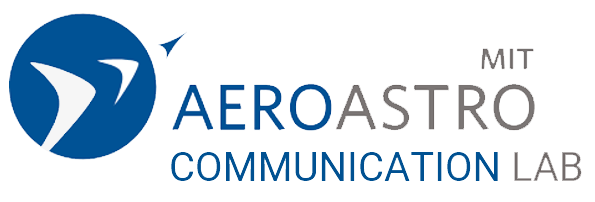1. Introduction
Conferences are one of the most exciting ways to share your work, but writing the paper to get there can be tricky. What do you say? How much do you say? How do you know it’s ready? This CommKit will break down the structure and overarching content behind a conference paper. Many of these techniques can also be applied to journal papers.
The usual process for presenting at a conference is:
- Complete an important milestone for your research
- Find a conference that milestone corresponds with
- Submit an abstract
- Get the abstract accepted
- Write and submit the conference paper
- (Optional, depends on the conference) Get feedback and implement revisions
- Give a poster or oral presentation at the conference
- The paper is published with the conference proceedings
This CommKit assumes that you have already completed your research milestone, have chosen a conference, and have submitted some kind of abstract. If you are looking for help writing an abstract, we have an Abstracts CommKit. If you are looking for advice for attending a conference or common conferences to attend, we have a Success at Conferences blog post.
If you want an outline for your conference paper, you can find one in the Additional Resources at the bottom of the page.
2. Criteria for Success
Your conference paper will be successful if…
- The paper contains all technical deliverables and supports all conclusions included in the abstract submission.
- The paper provides motivation, fills a gap in the field or shows progress towards doing so, and provides a direction for future work.
- The paper follows conventional formatting that includes an introduction, methods, results, and discussion.
- The paper expands on another form of presentation, such as a talk or a poster, that may have led conference attendees to the paper.
3. Purpose
The biggest barrier to writing a conference paper is not thinking you are ready. If you find yourself at a point in your research where you have made important progress, even if you have not completed the project itself, consider going to a conference. Sharing your work with other engineers can lead to connections and advice you would not have gotten otherwise.
There are two typical types of publications: conference papers and journal papers. The differences are described in this table. While this CommKit is focused on conference papers, the information should generally work for both, with some differences.
| Conference Paper | Journal Paper | |
|---|---|---|
| Content | Work in progress, part of a larger project | Completed, original task or project with impact |
| Audience | General and experts, people who “dropped in” for your talk and want to find out more | Subject experts, people who seek it out |
| Acceptance Process | Short review | Long peer review |
| Length | Shorter (~4-6 pages) | Longer (~10-20 pages) |
| Accompanying Info | Presentation (poster or talk) | None |
| Impact of publication on your academic progress | Immediate for active feedback and field development | Longterm |
| Due Dates | ~half year before the conference, but varies a lot | Rolling |
4. Analyze Your Audience
The first audience for your paper will be the people who attended the conference, followed by others who find it after the conference is over.
Consider the audience for your paper by looking at:
- Size of conference
- Larger conferences get a broader audience
- Topic of conference
- Is it “Aerospace” or is it “Specific Subfield: the Conference”? Is it a conference with a lot of students?
- Which session you were accepted into
- Conferences are broken into sessions that have titles for their topics, such as “Instrumentation” or “AI Applications”. What other papers would fit into it, and therefore, what kinds of people may see your paper title in the list
Remember, you will have a presentation attached to the paper, so some readers of your paper may be people who do not have a strong background in your work. This is both expected and encouraged: part of the purpose of attending a conference is to get diverse perspectives on your work that you would not think of otherwise
5. Structure Diagram
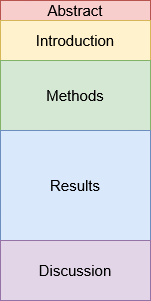
A diagram of the sections of a conference paper, scaled to the typical average length of each one.
6. Best Practices
6.1. Going from Abstract to Paper
For most conferences, you will submit an abstract first and then, upon acceptance, will write the full paper. Consider your abstract as your contract: anything mentioned in it should be in the final paper. Minor changes, like updating numbers, can be made, but if you promised a result in the abstract, it should be in the paper. Any major deviations should be approved with the conference organizers.
6.2. Introduction
The introduction is one of the most important parts of a conference paper, as many people will stop reading if the introduction does not grip them. Introductions have concrete formulas:
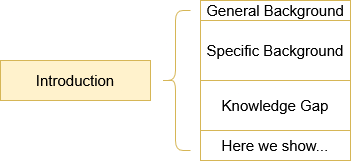
The parts of an introduction, scaled for their relative lengths.
6.2.1. General Background (2-3 sentences)
In a few sentences, introduce the broadest strokes of the concept. A common mistake for this section is to get too broad, ending up with papers that start with “Space is a really cool place.” More useful are things like “Orbital debris is a massive problem.” or “Robots need to be able to work on their own.”
6.2.2. Specific Background (4-6 sentences)
Get more into the specifics. Cover, in a logical order, what has already been done to bring the field to where it is today by citing other papers. This often looks like “the first try to solve this problem was this, an alternative was this…” Logically build an argument that has the answer of your…
6.2.3. Knowledge Gap (4-5 sentences)
Assert your claim to what is next for the field and introduce your idea as the way to fill that gap. Mention what nobody has yet done in those other papers, and why it is important for somebody (i.e. you) to finally do it. This is the most important part of your introduction.
Research, most broadly, is applying a new method to an old problem or an old method to a new problem. Where does your work fit into that? (Remember, your research cannot be “a new method for a new problem.” Something should be comparable to previous work.)
If you’re having trouble coming up with a knowledge gap, see the excerpt from Elements of the Academic Essay by Gordon Harvey at the end of this CommKit for ideas.
6.2.4. Here We Show… (2-3 sentences)
Tell your audience what the paper covers. You usually want to use the signifier phrase “IN THIS PAPER, WE…” or “HERE WE SHOW…” so your audience knows when you are transitioning from the conceptual to the concrete deliverables in this paper. List out the content in each section to close out your introduction.
6.3. Methods
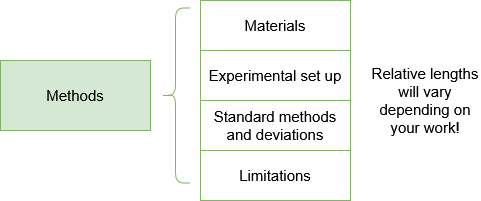
The parts of the methods section. All boxes are the same size, as the relative lengths will vary depending on your work.
In the methods section, you should discuss what you did, how you did it, and, especially, why you did it this way.
Methods include any tools you use in order to find a solution. These can be algorithms, procedures, models, pieces of hardware, pieces of software… any part of your process that you had to make a decision on what to use. Give context for standard methods and what, if any, alterations you did to them. For each part of your method, you should explain what purpose it fulfills towards solving your research problem, why you chose it, and justify its use over alternatives.
It is important to be honest and clear about the limitations of your methods, such as what assumptions you are using and what you did and did not account for. Do not be embarrassed by them: you assumed they were sufficient for this stage of your project for a reason. If you find you’re having a hard time justifying an assumption, consult with your advisor, who presumably signed off on this decision, how they would discuss it.
Finally, organize your work into a series of experiments you performed and the quantitative or qualitative criteria you used to assess the success of those experiments. This is usually best summarized in a table. Overall, this section should provide an explanation that someone could replicate to get the same solutions you did in your paper. In a conference paper, you do not have space to get into exacting detail for this, so only include minimal, essential detail.
6.4. Results

The parts of the results section. All boxes are the same size, as the relative lengths will vary depending on your work.
Results are any output from your work. You want to break this section into subsections for each experiment that you performed. Within each of those subsections, describe the observations you made and any observable, objective conclusions that you can draw from them. An important note: conclusions from your results are NOT the same as discussion. Generally, you want anything that you can objectively see from your data in the results section, and any interpretation in the discussion section. For instance, a result is “Algorithm A outperformed Algorithm B in metric Y.” A discussion would be “Algorithm A is the best one for solving this problem because…” Observations are only what you measured and nothing more. They should be objective, complete, and, if applicable, have numbers attached.
This section should almost always have the most figures of the paper. I often plan papers, and even research itself, by sketching out a figure I want to have in the results and working backwards. Think about what best summarizes the outcomes of your experiments and guides the reader to the conclusion you want them to reach. You MUST refer to every figure in the text of your paper, and each figure should have a descriptive caption. (If you need help making figures, check out the Figure Design CommKit). The last place you want to leave “exercises for the reader” is in your conference paper. Show you know what you are looking at and what you are not looking at.
6.5. Discussion
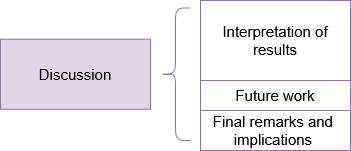
The parts of the discussion section, scaled to the relative length of each part. In some papers, future work and final remarks/implications are in their own section.
The discussion section is where you answer your “so what?” Discussions, like the introduction, is one of the most important parts of your paper, as many people will skim the discussions before deciding to read the rest. They are also important because they prove that what you have done is important and meaningful. Discussions can be difficult to put together, both because we are often self conscious of our limits and because we do not know how to properly scope broad claims.
Start with the knowledge gap you presented in the introduction. Your goal here is to prove that what you have shown has filled that gap. Now, you interpret your results. Break down what the numbers or observations mean within the context of your field. Are they an improvement, and, if so, within what context? Are they a contradiction? Something else? Explain why.
This naturally leads to future work: what you will be doing for your next paper. This can be further experiments or development, or it could be a limitation from your methods that you will be working to alleviate.
Finish your paper with final remarks about what this work means for the future. A good rule of thumb is to go “no more than 1 degree of speculation” away from these results. That is, if the next step of your algorithm would be faster performance for a specific application, do not promise that the robotic revolution is just around the corner.
Sometimes, future work and final remarks go in their own section, and sometimes they are included in the discussion. This is almost entirely a matter of preference.
7. Additional Resources
Excerpt from Elements of the Academic Essay by Gordon Harvey
- the truth isn’t what one would expect, or what it might first appear to be on first reading;
- there’s an interesting wrinkle in the matter, a complexity;
- the standard opinion of the text, or a certain published view, needs challenging or qualifying;
- a simple or common or obvious-seeming approach to this has more implications, or explains more, than it may seem;
- an approach to this that may seem irrelevant, isn’t;
- there’s a contradiction or tension here;
- there’s an ambiguity, something unclear, that could mean two or more things;
- this matter is difficult, or complicated, and needs some sorting out;
- there’s a mystery or puzzle or question here that needs answering or explaining;
- we can learn about a larger phenomenon by studying this smaller one;
- published views of the matter conflict;
- this seemingly tangential or insignificant matter is actually important, or interesting.
Acknowledgements
- Central Comm Lab Training series
- MechE Comm Lab Journal Paper CommKits
- Thank you to Abby Lee for her assistance and contributions.
